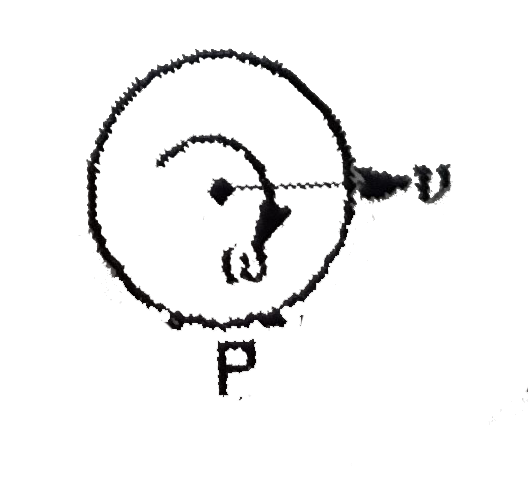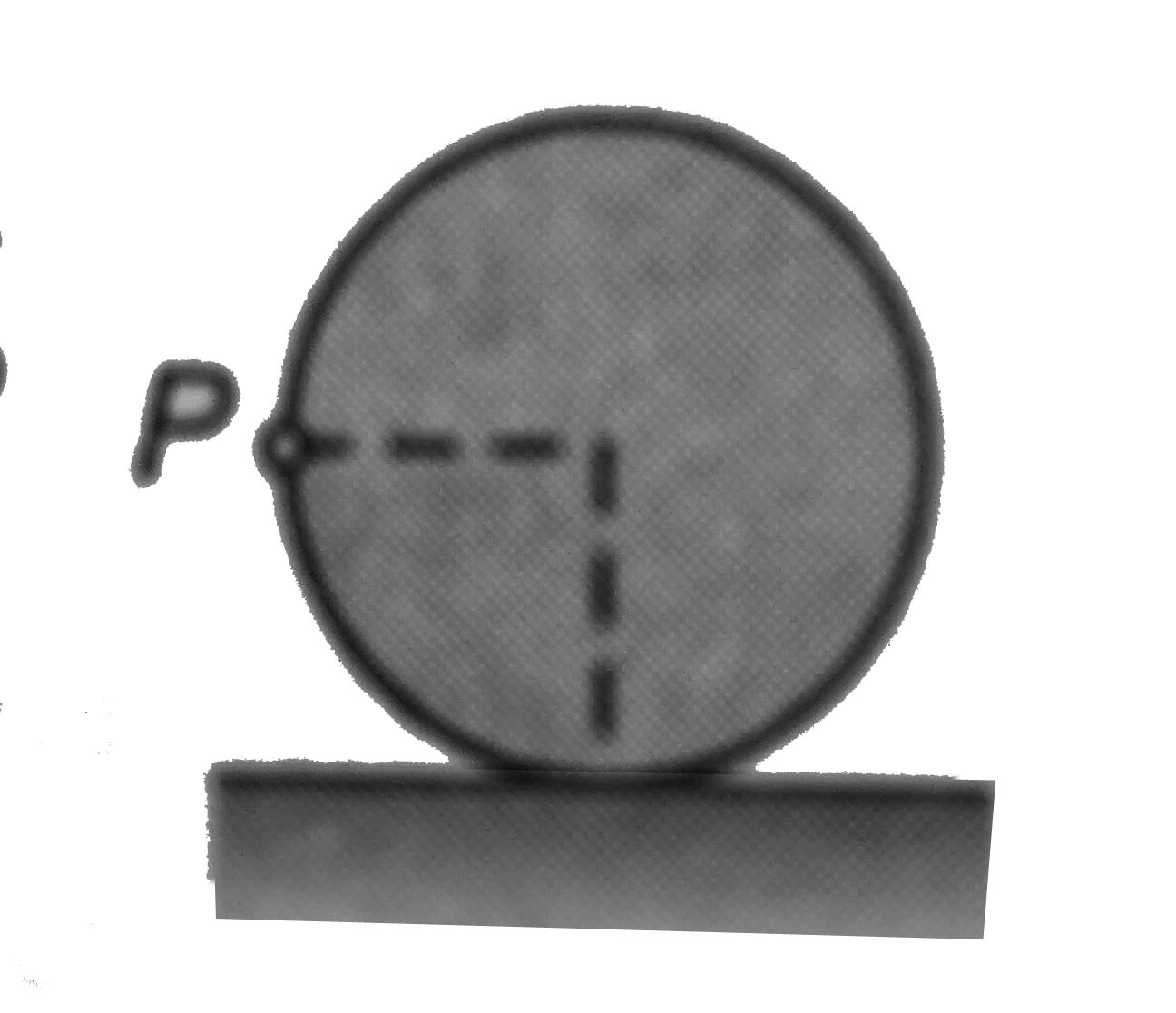A uniform circular disc of radius R is rolling on a horizontal surface. Determine the tangential velocity (i) at the upper most point (ii) at the centre of mass and (iii) at the point of contact.
To solve the problem of determining the tangential velocities at different points on a rolling uniform circular disc, we will analyze three specific points: the uppermost point, the center of mass, and the point of contact with the ground.
1. Understanding the Motion of the Disc:
- A uniform circular disc of radius R is rolling without slipping on a horizontal surface. This means that the point of contact with the ground is momentarily at rest.
2. Tangential Velocity at the Uppermost Point:
- The uppermost point of the disc is moving due to both the translational motion of the center of mass and the rotational motion about the center of mass.
- Let V be the translational velocity of the center of mass, and ω be the angular velocity of the disc.
- The tangential velocity at the uppermost point can be expressed as:
Vtop=V+ωR
- Since the disc rolls without slipping, we have the relation:
V=ωR
- Substituting this into the equation for Vtop:
Vtop=V+V=2V
3. Tangential Velocity at the Center of Mass:
- The center of mass of the disc moves with the translational velocity V.
- The tangential velocity at the center of mass is simply:
Vcm=V
4. Tangential Velocity at the Point of Contact:
- The point of contact with the ground is at rest when the disc rolls without slipping.
- Therefore, the tangential velocity at the point of contact is:
Vcontact=0
Summary of Results:
- (i) Tangential velocity at the uppermost point: Vtop=2V
- (ii) Tangential velocity at the center of mass: Vcm=V
- (iii) Tangential velocity at the point of contact: Vcontact=0
- A uniform circular disc of radius R is rolling without slipping on a horizontal surface. This means that the point of contact with the ground is momentarily at rest.
- The uppermost point of the disc is moving due to both the translational motion of the center of mass and the rotational motion about the center of mass.
- Let V be the translational velocity of the center of mass, and ω be the angular velocity of the disc.
- The tangential velocity at the uppermost point can be expressed as:
Vtop=V+ωR
- Since the disc rolls without slipping, we have the relation:
V=ωR
- Substituting this into the equation for Vtop:
Vtop=V+V=2V
- The center of mass of the disc moves with the translational velocity V.
- The tangential velocity at the center of mass is simply:
Vcm=V
- The point of contact with the ground is at rest when the disc rolls without slipping.
- Therefore, the tangential velocity at the point of contact is:
Vcontact=0
- (i) Tangential velocity at the uppermost point: Vtop=2V
- (ii) Tangential velocity at the center of mass: Vcm=V
- (iii) Tangential velocity at the point of contact: Vcontact=0
Topper's Solved these Questions
- ROTATIONAL MOTION BOOK - CBSE COMPLEMENTARY MATERIALCHAPTER - ROTATIONAL MOTION EXERCISE - NUMERICALS
12 Videos
- ROTATIONAL MOTION BOOK - CBSE COMPLEMENTARY MATERIALCHAPTER - ROTATIONAL MOTION EXERCISE - ROTATIONAL MOTION (5 MARKS)
2 Videos
- ROTATIONAL MOTION BOOK - CBSE COMPLEMENTARY MATERIALCHAPTER - ROTATIONAL MOTION EXERCISE - ROTATIONAL MOTION (2 MARK)
15 Videos
- PROPERTIES OF MATTERBOOK - CBSE COMPLEMENTARY MATERIALCHAPTER - PROPERTIES OF MATTEREXERCISE - MULTIPLE CHOICE QUESTIONS (MCQs)
20 Videos
- THERMODYNAMICS BOOK - CBSE COMPLEMENTARY MATERIALCHAPTER - THERMODYNAMICS EXERCISE - MULTIPLE CHOICE QUESTIONS (MCQs)
20 Videos
Similar Questions
Knowledge Check
A spherical body of radius R rolls on a horizontal surface with linear velociltly v. Let L1 and L2 be the magnitudes of angular momenta of the body about centre of mass and point of contact P. Then:
 AL2=2L1 if radius of gyration K=RBL2=2L1 for all casesCL2>2L1 if radius of gyration K<RDL2>2L1 if radius of gyration K>R
AL2=2L1 if radius of gyration K=RBL2=2L1 for all casesCL2>2L1 if radius of gyration K<RDL2>2L1 if radius of gyration K>R
A disc of radius R is rolling purely on a flat horizontal surface, with a constant angular velocity the angle between the velocity ad acceleration vectors of point P isAzeroB45∘Ctan−1(2)Dtan−1(1/2)
A uniform circular disc of mass m is set rolling on a smooth horizontal table with a uniform linear velocity v. Find the total K.E. of the disc.
View SolutionA circular disc of radius r is rolling without slipping on a horizontal surface. What is the ratio of the translational KE and rotational KE of disc ?
View SolutionA circular disc of radius R rolls without slipping along the horizontal surface with constant velocity v0. We consider a point A on the surface of the disc. Then the acceleration of the point A is:
View SolutionA circular disc of radius R rolls without slipping along the horizontal surface with constant velocity v0. We consider a point A on the surface of the disc. Then the acceleration of the point A is:
View SolutionA circular disc of radius R rolls without slipping along the horizontal surface with constant velocity v0 . We consider a point A on the surface of the disc. Then, the acceleration of point A is
View SolutionA thin ring of mass m and radius R is in pure rolling over a horizontal surface. If v0 is the velocity of the centre of mass of the ring, then the angular momentum of the ring about the point of contact is
View Solution
